We were without power for 24 hours, which wasn’t very long, considering how damaging the storm was and how many nearby communities were walloped far harder than us. In any event, my son and I, and dogs, (my husband has a knack for being out of town during severe weather) hunkered down in front of the fireplace. By the time the lights came on there was a nice pile of ashes in the hearth.
After the storm passed, I inspected the damage. All of the animals were fine, and inside the barns it was dry and comfy. But the chickens’ pens had became a soggy, slippery mess. It’ll be days or longer before there’s a nice pile of dirt to dust bathe in. Dust bathing is essential for their health. It’s what keeps the lice at bay and keeps their feathers in fine form. The ashes were just what the hens needed. So, I divided them between two kitty litter boxes and added an equal amount of DE (food grade diatomaceous earth).
I then stirred in coarse sand (leftover from installing the goat patio). I put one of the boxes in the HenCam flock’s run. Candy, of course, laid claim to it.
I shooed her out and the hens took their turns. Agnes was practically upside-down with enthusiasm.
The Gems were not so sure what to do with the purple box. The girls stared and glared, walked through and pecked at it. Eating dirt and ashes is fine. In fact, bits of coarse sand are good for their gizzards. Watch a hen dust bathe and you’ll see that they eat dirt as they groom.
I haven’t seen a Gem dust bathe yet, but I’m sure they’ll figure it out soon.
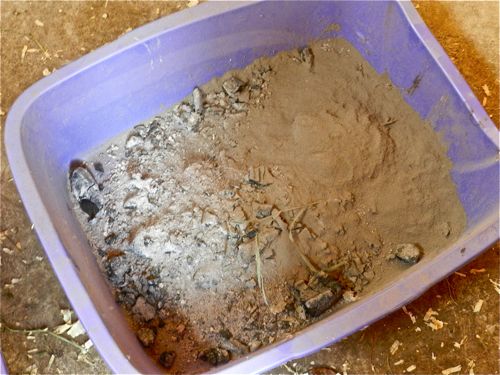
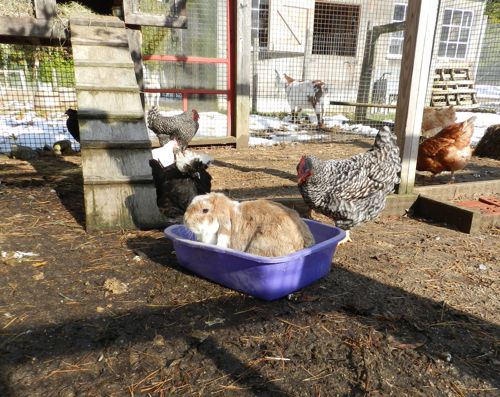
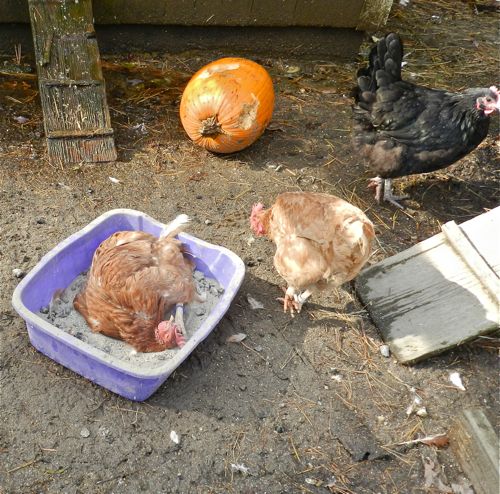
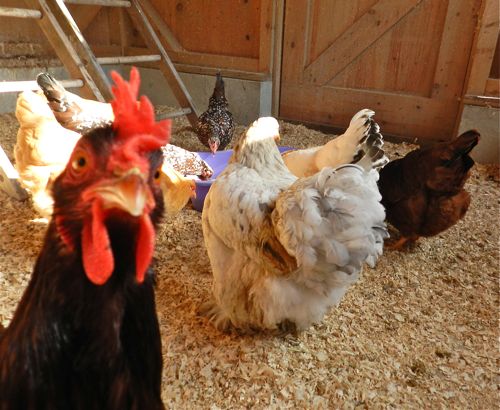
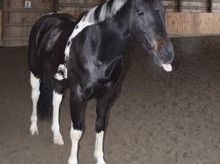
Hahaha!!! I LOVE that picture of Candy. She is absolutely the queen of the barnyard.
I’m pleased the storm didn’t cause too much damage for you.
The photo of the Gems figuring out what the bowl of ash and dirt is for, is just brilliant!!!
Little Cheep made herself a dust-bath today, in a sunny spot under the big conifer. She’s only 2 months old, but she’s such a quick learner! (I say ‘she’ with crossed fingers!)
Celia
How funny is Agnes! Good for her. I went to a Poultry exhibition this past weekend. I was so disappointed there were not many of the ‘heritage breed’ chickens. There were 4 of what I expected to be ‘regular size’ chicken. The two cochins were fabulous. There was a black australorp that was beautiful. Majority of the chickens were the bantam size. I’m wanting some hens and looking to see what they truly look like and their sizes for the coop I will need to construct. Terry, you have made this so fun!
Thank you for the great suggestion!
Pure chicken bliss for Agnes. I have never seen a happier chicken. Love your blog, BTW!
I wondered what was in that bin when I logged on and saw Buffy in it, very busy. You think of everything!
Hi there,
Isn’t it crazy getting that much snow before the leaves fall off the trees!?!
I want to tell you that I happened to visit a while back when you had just posted about washing messy chicken bottoms, treating lice and vent gleet. Well, I have lost about three chickens over the years to what I now realize is vent gleet. Within a few days after reading your post, my sweet Big Rooster fell ill and I immediately knew what it was. The lightbulb came on when I picked him up and smelled that horrible smell.
I am thrilled to report that I treated him holistically and he has survived. I don’t know how though. His back side opened up to the point he really needed to be stitched. I could see inside him and was horrified. But somehow he managed to heal (mostly) and he is acting like a normal rooster now.
I am thankful I stumbled upon your blog. You are the reason he is alive today. Thanks for all the great information and cute pictures!
I’m so pleased the povidone helped! It’s amazing what chickens can recover from when you figure out the right treatment.
Candy and Agnes in the bowl of ash are so funny. I have never seen a more blissful dust bather than Agnes.
A word of warning regarding ashes. If you burn oak in particular, it is important to let the ashes lay in the rain for a while to leach the lye out of them.
A couple years ago I decided to sift the ash pile in the spring. I ended up with lye burns on my fingers. There had not been much rain and the lye had not leached out.
I also use the mix you made for dust baths, but the ashes have leached first.
Interesting!
Love the hen staring in the camera!! Who is that in there????
One of the RIRs.
Aren’t they hilarious when they dust bathe? As a chicken newbie last year, I didn’t fully grasp the importance of dust baths until winter came on and the girls had only a muddy, wet run to roam around in. In midwinter I let them out into the yard and they immediately headed for the dry, sandy soil under the house eaves, and proceeded to practically turn themselves inside out with joy, 6 of them crammed into about 3 square feet, dust bathing. After that I realized it was a real need, and I rigged up a cat litter box like yours (I’m sure I saw the photo on your blog) with ashes, DE and dry soil. It’s about time to do that again, though this year they will have 2 covered runs to stay dry in. Thanks for sharing the doings of your critters.
Have you thought about sand for the run? I have sand in mine and love that I don’t need to worry about sliping and sliding in the mud.
I’ve added sand countless times. Eventually is disappears. (My property is on granite/gravel and stuff just seeps down and out.) The chickens are always happy when I add another wheelbarrow load of sand, though!
I did catch a gem bathing in the ashes today (Wed), so I guess they are figuring it out. I knew they ate dirt and rocks but I was surprised about the ashes – what does that do digestively? So alkaline!
Glad You got through the storm ok – I sure don’t envy you. This is prime gardening time for me!
I don’t know what the ashes do exactly. Perhaps they help detoxify things in the gizzard, just like a charcoal filter? So much to learn!
Hi Terry, i’m about ready to get some chickens for the first time, should i clorox the inside of the chicken coop. prior to getting the birds to give them a better chance at not getting some sort of parasites? Do u add des ro the ground outside the coop or put in their nesting boxes and inside on the floor. I just want to give them the best chance at staying healthy and parasite free. thanks robyn
Are you using an old coop that has had chickens recently? Unless that’s the case, don’t worry about it. However, do make sure that your coop is properly ventilated, and has plenty of sunlight. Once the chickens arrive, keep it clean and dry. They’ll be fine!
That’s a fabulous idea. I need to do something like that. We didn’t get snow, but lots of rain.
hi terry,i am building a new coop and i have allways have wanted a bunny to go with the chickens and i just thought know was a good time to get one.i am getting it sometime soon it is a lop-eared bunny its a boy he is about one years old i would like to know any tips about takeing care of one and will it be okay to live with my chickens and if the bunny has been inside can it go outside??-kristen. tkanks for any info
I have a FAQ about this topic. It’s a lot of fun to have a bunny with the chickens. I love my lop, but they don’t make the best outdoor rabbits – they don’t have control over their ears and so the ears can get too cold and can’t help dissipate the heat. Candy’s also tend to get fungal infections that need frequent treatment. Also, make sure you neuter your rabbit! That said, enjoy!
thanks it sounds like a lot of fun. but can any of those sickness spread to humams?
Hi Terry! Lots going on in the coop today! Do you have visitors?
The brilliant Karen Pryor was here for a photoshoot! I’ll have pictures up next week.
Hi terry,what would you give bunnies if they get sick?? can i put a lop-eared bunny outside in the winter if not when do i do it?
Kristen, I think it’s too late now to get an outdoor bunny. They have to put on a winter coat – even in South Carolina. When my bunny gets sick I take her right to my vet.
ohh and i live in south carolina so its not that cold here at all .
okay thank you i will put her out in the spring